The largest cemetery in Paris is Père Lachaise, which opened in 1804 and imported some of its first residents, such as Molière, from other graveyards as a promotional ploy to make the fairly remote site more attractive to potential tenants. This tactic evidently paid off because today there is a long waiting list for admission and plots are rented out in 30-year leases. Here's a closer look.

Cimetière du Père Lachaise.
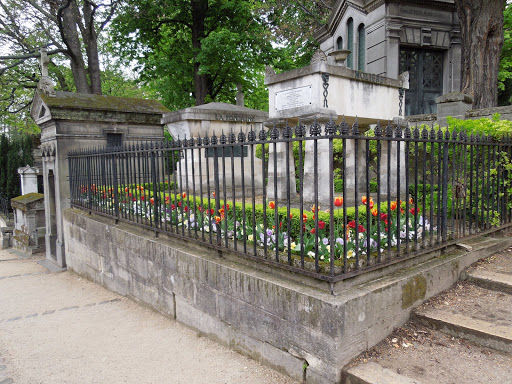
The grave of Jean-Baptiste Poquelin, better known as Molière, French comedic playwright known for Tartuffe and The Misanthrope.




Édith Piaf, the "Little Sparrow," was a beloved French chanteuse famous for songs like "La Vie en rose" and "Non, je ne regrette rien." Her last words were "Every damn fool thing you do in this life, you pay for."



James Douglas Morrison, dionysian lead singer of The Doors who died mysteriously in a bathtub in Paris. Conspiracists believe his death was faked and he still walks among us.

A bust of Morrison once topped the grave but it was stolen.


The grave of Irish poet, playwright, and perennially-quoted wit Oscar Wilde, who died in a Paris hotel in 1900. His alleged last words were "My wallpaper and I are fighting a duel to the death. One of us has got to go." The Picture of Dorian Gray, The Importance of Being Earnest, and The Ballad of Reading Gaol are a few of his notable works.

The most popular attraction in the place, Wilde's grave was surrounded by a cluster of youths when I first approached. "Who's this guy again?" one of them asked his pal.


The monument is currently barricaded to prevent exuberant visitors from kissing the surface of the sculpture, which has become a tradition of sorts. Presumably cemetery management was concerned about erosion.

Marcel Proust, best known for the seven-volume magnum opus, À la recherche du temps perdu. See my earlier entry Literary Paris for a museum exhibit of his cork-lined bedroom.
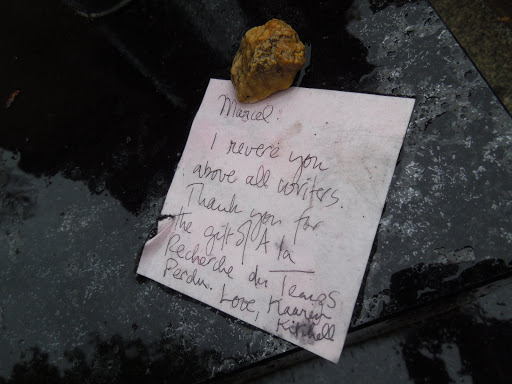
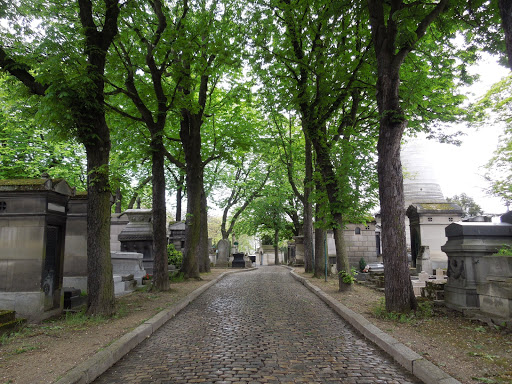

Honoré de Balzac, novelist and playwright, proponent of Realism. Known for his Human Comedy collection.



Georges Méliès, illusionist and film pioneer. Everyone has seen clips from his movie Le Voyage dans la lune whether they realize it or not, specifically the shot of a rocket poking a custard pie-faced moon in the eye. During World War I the bulk of his original prints were melted down to make boots for French soldiers. Only a handful survived. Méliès' life was recently exhumed for the Martin Scorsese Oscar-winner Hugo.



Through the gates and back to the world of the living.
18 May 2012
Cemeteries of Paris (part 2)
14 May 2012
Cemeteries of Paris (part 1)
What to say about cemeteries other than they are peaceful on first glance, but below the surface lie the remnants of those who long before we existed built worlds, set them afire, and built them up again. This makes the hallowed grounds ideal for contemplation, reflection, a sense of historical perspective, and, occasionally, album cover art.
Paris lays claim to several of the most magnificent cemeteries in the western world and here are the results of a somber jaunt through the great cemetery of Montparnasse.

The entrance to the Cimetière du Montparnasse.

The shared grave of Jean-Paul Sartre, key figurehead of existentialism, and Simone de Beauvoir, feminist and social theorist.

Railway tickets are a popular token to leave behind on French gravesites. I wonder if it symbolizes the journey into death or are just readily available. A cruel trick, I feel, to slip the dead an expired ticket.


The resting place of Charles Baudelaire, an early Symbolist poet most famous for Les Fleurs du mal ("The Flowers of Evil"). As I paid my respects a gentleman sat nearby, silently reading poetry, presumably Baudelaire's but it could've been Edward Lear's for all I knew.
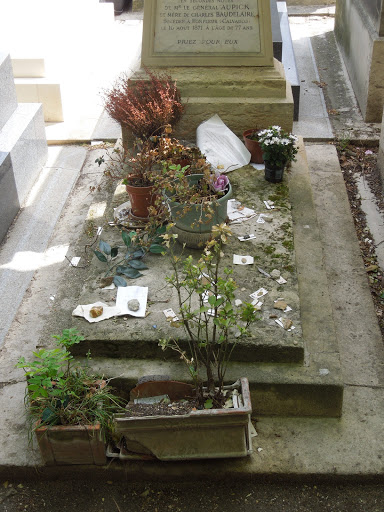

Serge Gainsbourg, popular French singer-songwriter and worldly lech.

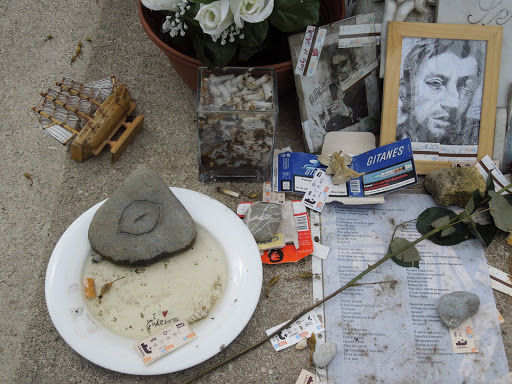

Samuel Beckett, Irish avant-garde novelist and playwright. His best-known work is probably the absurdist play Waiting for Godot.
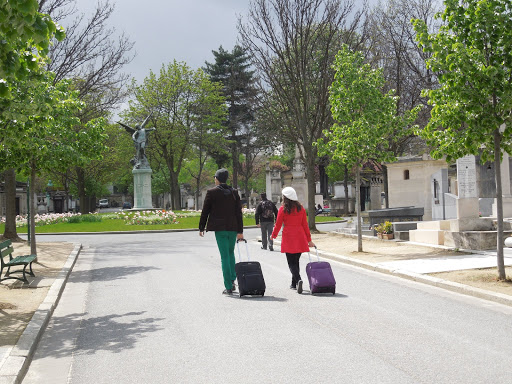
Two visitors prepared for an extended stay.

Theatre of the Absurd playwright Eugene Ionesco, author of Rhinoceros and The Bald Soprano.

Man Ray, American surrealist photographer and painter.

Jean Seberg, actress from À bout de souffle and Bonjour tristesse. Hers was a tragic life.
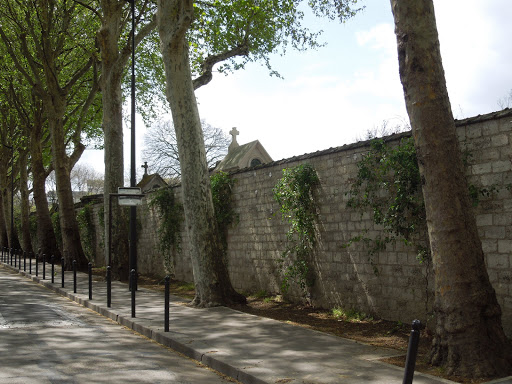
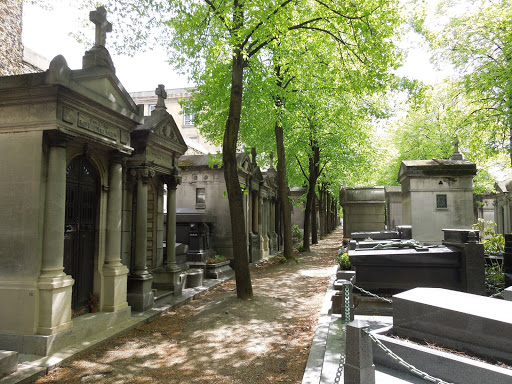

Lt Colonel Alfred Dreyfus, unfairly charged with treason in 1894. The Dreyfus Affair sharply divided French society of the time. The writer Émile Zola rose to his defense in an open letter called "J'accuse" in which he denounced the French government for anti-Semitism.

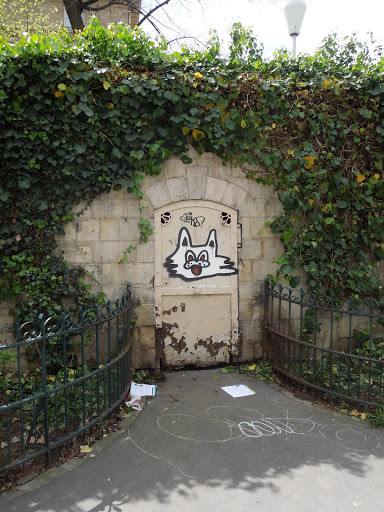
This must be the entrance to the pet cemetery.
11 May 2012
Literary Paris
"You are all a lost generation," insisted Gertrude Stein. The importance of this statement is disputable, since what generation is otherwise? But it made for good copy and paved the way for generations Beat, X, and Pepsi. In the wake of the Great War, the members of une génération perdue made their way to Paris, where artists could live cheaply, and drunkenly, unlike in the States where Prohibition reigned.
I took a few hours one drizzly afternoon to wander through the Latin Quarter and Saint-Germain-des-Prés districts seeking out a few old literary haunts.

Shakespeare and Company, at 37 rue de la Bûcherie near the Seine. Opened in 1951 under the name Le Mistral, this bookstore was later renamed as a tribute to Sylvia Beach's influential bookstore which catered to the Lost Generation in the twenties. Aside from having an intimidating selection of English language books, Shakes & Co has a reputation for being notoriously supportive of struggling writers, even so far as letting them crash on an upstairs cot in exchange for a few hours of work. Its beloved owner George Whitman passed away in 2011, leaving the shop in the hands of his daughter Sylvia.

A mural of writers along the stairway. Clockwise: Gertrude Stein, Ernest Hemingway, Djuna Barnes, Henry Miller, Jean Rhys.

The upstairs room at Shakespeare and Company is filled with the dusty remnants of Sylvia Beach's library.
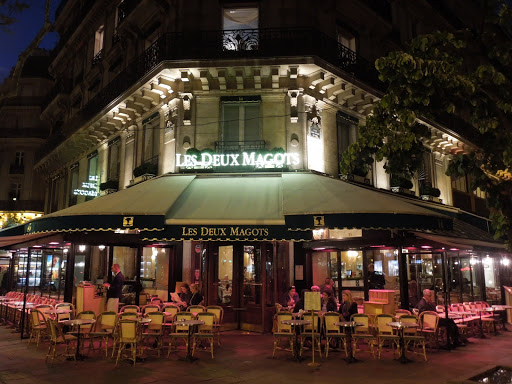
Les Deux Magots was a favorite meeting place of intellectuals and writers such as Jean-Paul Sartre, Simone de Beauvoir, Camus, André Gide, Jean Cocteau, and André Breton.

The two magots, silk traders from the provinces who opened a fabric shop on this location in 1873.

Café de Flore on Boulevard Saint-Germain was another favorite hangout of the existentialists and painters like Picasso and Marc Chagall.


Hemingway wrote about La Closerie des Lilas in A Moveable Feast, one of his favorite spots to write, at least until the restaurant converted to an American Bar and a waiter was indignantly forced to shave off his mustache.

27 rue de Fleurus was the home of Gertrude Stein and Alice B Toklas, an art-bedecked salon for expatriates. Ezra Pound, Hemingway, Picasso, Thornton Wilder, and Sherwood Anderson were a few of the notables prone to dropping by to endure Stein's sharp criticisms.
 '
'
Hemingway moved to this stately apartment at 6 rue Férou after The Sun Also Rises was published and the money started rolling in.

Henry Miller lived in a fifth floor garret of this hotel at 36 rue Bonaparte for 500 francs a month. He wrote detailed letters about his time here to his childhood friend Emil Schnellock, later collected in the volume titled, appropriately, Letters to Emil.

In 1921 Sylvia Beach moved her fledgling bookstore Shakespeare and Company to this address at 12 rue de L'Odeon, where expatriates soon gathered to schmooze and take advantage of Beach's lending library. Beach was the only soul brave enough to publish James Joyce's Ulysses in 1922. The shop was eventually shut down by Nazis during the occupation.

While waiting under an awning for the rain to let up I noticed with envy this shop window full of vintage Jules Verne.

This former flophouse at 9 Rue Gît-le-Coeur was known as the Beat Hotel, where various Beat Generation writers stayed when they were in town in the fifties because the prices were so cheap. Today they probably wouldn't be able to enter the lobby of this now-upscale joint without raising suspicion.


James Joyce lived here at 71 rue du Cardinal Lemoine while putting the finishing touches on Ulysses.


Down the street from Joyce, Hemingway lived on the third floor of 74 rue du Cardinal Lemoine when he first arrived in Paris. The boutique on the ground floor is called Under Hemingway's.

The symbolist poet Paul Verlaine died of pulmonary congestion here at 39 rue Descartes. Hemingway also rented a garret in the building for use as a writing room.

George Orwell stayed in this former boarding house at 6 rue du Pot de Fer while working as a dishwasher in the ground floor restaurant. A narrative on his foray into poverty was published in 1933 as Down and Out in Paris and London.

A glance upwards.

Across the Seine on the Right Bank, at the southeast corner of Place des Vosges, lies the stately Maison de Victor Hugo. The legendary French novelist and poet lived here for sixteen years, where he penned a large portion of Les Misérables. It is now preserved as a museum.

Marcel Proust's bedroom where he painstakingly pieced together the seven volumes of À la recherche du temps perdu is on display at the Musée Carnavalet. The walls were lined with cork to muffle the noise of the city.